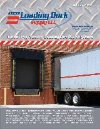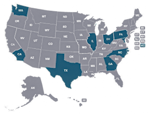Pit LevelersCurrent lead time stock to 6 Weeks Pit levelers, by design, are recessed directly into the loading dock within a dock pit. Whether mechanical or hydraulic they offer a greater operating range than edge of dock levelers or vertical storing levelers with ranges up to 12" above/below dock. This range makes them ideal for diverse trailer fleets. Constructed with 55,000 lb. minimum yield steel tread plate, they meet ANSI MH-14.1 and OSHA standards for safety and performance. Why Choose Pit Levelers from Loading Dock Supply?
Have Questions? MECHANICAL PIT LEVELER MODEL "C" The Pioneer C series is a contractor-grade leveler, perfect for standard applications where custom features like galvanization aren’t needed. Its spring-loaded design ensures reliable operation without power requirements. Capacities: Features: MECHANICAL PIT LEVELER MODEL M The Mechanical Pit Leveler Model M is exclusively constructed with a solid “C” Channel deck support, and dual 60,000 lb. safety legs for additional strength and support. With its direct extension spring design and hydra lip extension the M series offers maximum utility. Deck and lip are constructed of 55,000 lb. minimum yield steel tread plate. Lip keepers serve as night locks for security and provide safe cross traffic support when unit is stored. Dock Bumpers and grease fittings on lip hinge are standard with each unit. These features coupled with an easy pull chain and walk down activation make this leveler one of the simplest to use for day to day use. Capacities: Features: HYDRAULIC PIT LEVELER MODEL EHP The EHP series Hydraulic Pit Leveler offers both strength and ease of use. With its single rotary switch control, activation and cycling of the leveler may be achieved when the truck departs or while the truck is still docked. The hydraulic deck and lip offer smooth, efficient operation of the leveler. Deck and lip are constructed of 55,000 lb, minimum yield steel tread plate. Lip keepers serve as night locks for security and provide safe cross traffic support when unit is stored. Dock Bumpers and grease fittings on lip hinge are standard with each unit. Hydraulic: Features: HYDRAULIC PIT LEVELER MODEL HP The HP series Hydraulic Pit Leveler, exclusively constructed with a solid C Channel deck support, provides superior construction at a fraction of the cost. With its Solid State Proximity Sensors and 1 HP, 1.3 GPM Hydraulic deck and lip, the HP series automatically returns to a safe cross traffic position when the truck departs. Full width cold roll CF 1045 steel pin, seamless tubing and 55,000 lb. minimum yield steel tread plate Deck and lip make this the most durable leveler we offer. Lip keepers serve as night locks for security and provide safe cross traffic support when unit is stored. Laminated Dock Bumpers and grease fittings on lip hinge are standard with each unit. Hydraulic: Features PIT LEVELER PAN FORM Ensure a square and accurate casting of your dock pit with a Pit leveler Pan Form from Loading Dock Supply. Available in a range of dimensions and models suited to both mechanical and hydraulic pit levelers, our bolt together pit kits come complete with the curb angle and three steel panels you'll need to get a true fit with every installation. Features: Dimensions: Get A QuotePit Leveler Pan Form InstallationSubmittal Drawing |
Dock Compatibility Guide for Pit Levelers (2025)Your loading dock keeps your business moving, and a pit leveler is the backbone of safe, fast operations. At Loading Dock Supply, we’ve been equipping warehouses and installers across all 50 states with reliable pit levelers for years. This guide cuts through the noise to help you pick the right one—whether you’re a business owner streamlining logistics or an installer ensuring a perfect fit. We’ve packed this guide with practical steps, specs, and tips based on industry standards to make your decision simplified. Last Update: August 02, 2025 Have questions? Call us at 1-800-741-1258 or email sales@loadingdocksupply.com for a fast answer. Why Choose a Pit Leveler?Pit levelers are built for heavy-duty docks, offering more range and strength than edge-of-dock models or portable plates. They adjust for trailer movement, keep your team safe, and speed up loading. Here’s why they matter:
Business owners: This means fewer delays and lower maintenance costs. Installers: You get equipment that’s easy to set up and built to perform. Pit Leveler Types: What’s Right for Your Dock?
Pick the type that matches your traffic, budget, and setup. Here’s the breakdown:
Key Specs to CheckMake sure your leveler fits your dock and workload:
How to Choose the Right Pit LevelerHere’s how to nail the decision, whether you’re managing costs or installing:
Dock Compatibility Chart:
Download our Dock Survey Form to confirm measurements. Installation: Set It Up RightPlan for 1-2 weeks total, with 4-8 hours to place the leveler. Pros are best; labor runs $800-10,000. Pit Prep Options:
Steps:
Tools: Welder, forklift, compactor. Use barriers to keep it safe. Pro Tip: For retrofits, measure existing pit depth to avoid costly concrete work. Maintenance: Keep It Running SmoothRegular care means 7+ years of reliable use:
|




